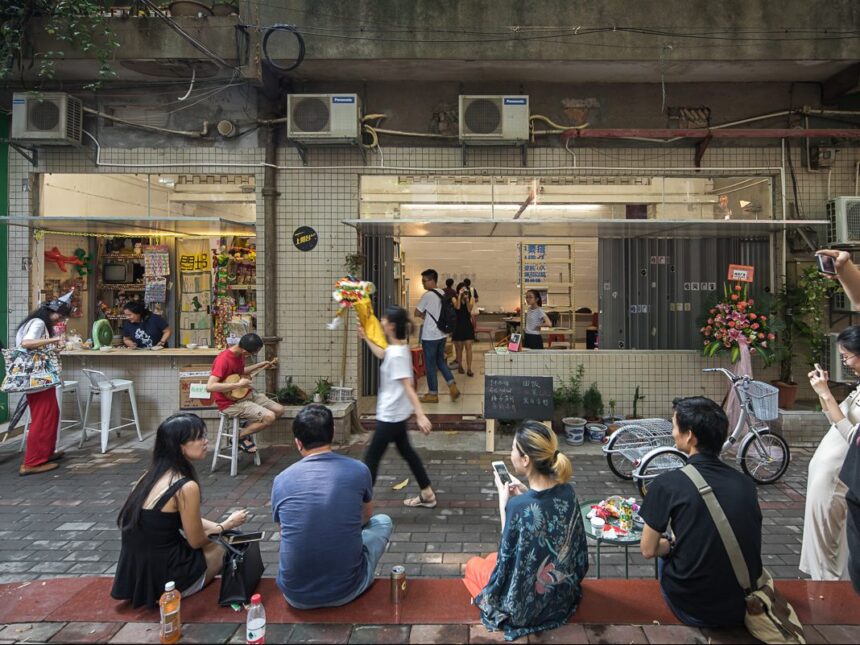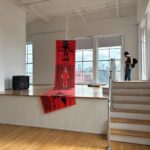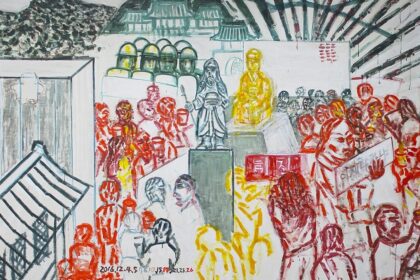Playing Cool Under the Iron Ceiling: The Current State of Socially Engaged Art in Mainland China
Bo Zheng
China remains an authoritarian state. The Communist Party, with 89 million members, remains the paramount political, economic, and social institution. President Xi Jinping, who became the leader of the party-state in 2012, quickly consolidated power, and succeeded in changing the Constitution in 2018 to allow him to rule for life. The Chinese economy, not much affected by the 2008 financial crisis, continues to grow at a rapid pace. Beijing and Shanghai have joined the ranks of global cities, boasting not only glitzy financial centers but also vibrant cultural districts.
In the discursive field of contemporary Chinese art, which is now dominated by the online circulation of articles via social networking app WeChat, the phrase “political art” is almost non-existent. Censorship and self-censorship ensure that no reference to the party-state, its logos or leaders, can be made. On the other hand, “community,” “participation,” and “intervention” have become trendy topics, with ample debates on their merits and limitations. In short, Chinese artists and critics today cannot touch politics, which is in total control of the party-state, but are encouraged to engage with the social.
Who is encouraging this interest in social engagement? The urban middle class, who have gained adequate material comfort and financial security – Shanghai’s GDP per capita exceeded US$19,000 in 2017 – now want to give their lives a bit more meaning; the younger-generation artists, in their twenties, well educated in art and critical thinking, with access to information in both Chinese and English, now consider both counterculture and self-organizing “cool” and “smart.” Additionally, art museums are popping up all over China, many of them set up by real estate companies to enhance their brands, and they see “community oriented programming” as an important path to attracting audiences.
Let me give one example: In 2012 when Huang Xiaopeng, a Chinese artist known for incisive works satirizing mass culture, was pushed out of Guangzhou Academy of Fine Arts (one of the top art schools in China), the Times Museum in Guangzhou, a private museum under the real estate conglomerate Times Group, invited Huang to set up an alternative education platform – named “Huangbian Station” (黄边站) – in the storefront space adjacent to the museum entrance. Xu Tan, a well-established artist who has turned to a research-based practice in recent years, and Liang Jianhua, a seasoned museum worker, joined Huang. They organized discussions and set up courses for aspiring artists and recent art school graduates. Huangbian Station quickly became the de facto community center for young artists in Guangzhou. In 2016, members of Huangbian Station made several trips to visit other self-organizing groups in other Chinese cities, including Dinghaiqiao Mutual-Aid Society (定海桥互助社) in Shanghai, Youth Utopia (青年乌托邦) in Wuhan, and Wall & Water Bookstore (失败书店) in Shenyang. All these groups were founded and run by well-educated young cultural workers: artists, designers, musicians, and writers. Huangbian Station also set up an exhibition in the Times Museum and invited other independent groups in Guangzhou, such as Fong Fo (馮火), a monthly DIY publication launched in March 2013, to join. After the exhibition, they concluded that they needed to become independent of the museum, and move to a space that was more conveniently located and really embedded in a community. This led to the creation of “SoengJoengToi” (based on the Cantonese pronunciation of the Chinese name 上阳台, meaning “up the balcony”). SoengJoengToi, or SJB, became an association of independent groups, who share one physical space.


Last month I visited SJB on a quiet weekday morning. Occupying a ground-floor apartment of a 1980s residential building, it looked like a storage space filled with junk hoarded by a hippy. Seventeen groups are co-owners (down from a peak of forty) of the space, which has hosted: a second-hand store, a bar selling locally brewed beers, a barbershop (charging significantly lower prices than nearby salons, thus endearing itself to senior residents in the neighborhood), a Kungfu school, an underground film screening group (against the backdrop that film distribution is tightly controlled by the party-state), a lecture series (on serious topics, such as “The Gentrification and Privatization of Workers’ Housing in Sydney”), an advertising agency (specializing in community advertising), among other initiatives. Architect Liu Yang has skillfully transformed the 750-square-foot apartment into a flexible multi-use jungle, open to the courtyard shaded by trees. Stickers with brainy slogans and chic graphics dotted the entire space. Canvas bags, indie magazines, and a few cats roaming around signaled SJB’s membership in the global cool. However, “looking cool doesn’t mean that you’ll be safe,” according to a member of SJB. I was told that an LGBTQ party earlier this year may have earned SJB a spot on “the blacklist,” meaning they may be subject to monitoring by state security.
The line between the social and the political is always uncertain. Many experienced practitioners, including myself, were shocked when in 2015 five young women were arrested for trying to start a public campaign against sexual harassment on public transportation. They were markedly different from those previously targeted by the party-state: human-rights lawyers, labor organizers, and liberal intellectuals. They were five educated women in their mid-twenties to early-thirties, working on gender issues that had not been seen as overtly political or threatening. What may have startled the party-state was their attempt to launch a synchronized campaign in multiple cities. In other words, the party-state is vigilant against organizing, regardless of issues.
The majority of Chinese political-financial elites remain extremely confident about China’s current path – authoritarian party-state coupled with market economy – the legitimacy of which may only be strengthened as authoritarianism rises in the US and parts of Europe. Yet the bottom-up desire of a growing public interested in communal practices, in greater tolerance for cultural, sexual, and spiritual diversity, and in participatory democracy, albeit on a local scale, will continue to grow. Young groups like SJB are springing up all over China. The field of Chinese socially engaged art may resemble a garden with a hundred flowers, under a low iron ceiling.
Bo Zheng is an artist and writer specializing in socially and ecologically engaged art. His research team has created an online archive and MOOC titled “Socially Engaged Art in Contemporary China” (http://seachina.net/). Zheng is FIELD’s Corresponding Editor for China. He is also an editorial board member of the Journal of Chinese Contemporary Art. He recently co-edited (with Dr. Sohl Lee at SUNY Stony Brook) a special issue titled “Contemporary Art and Ecology in East Asia.” He teaches at the School of Creative Media, City University of Hong Kong.










